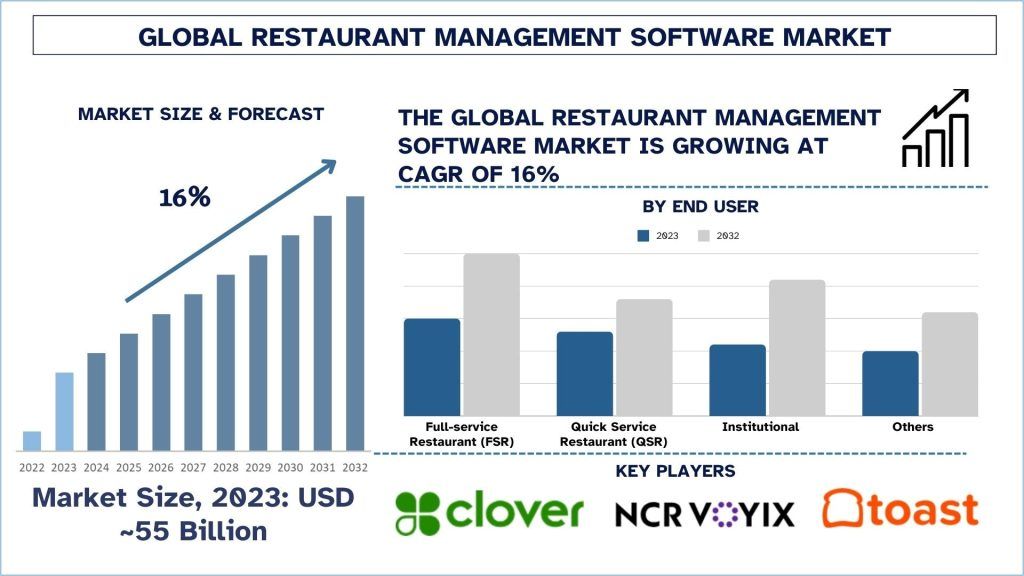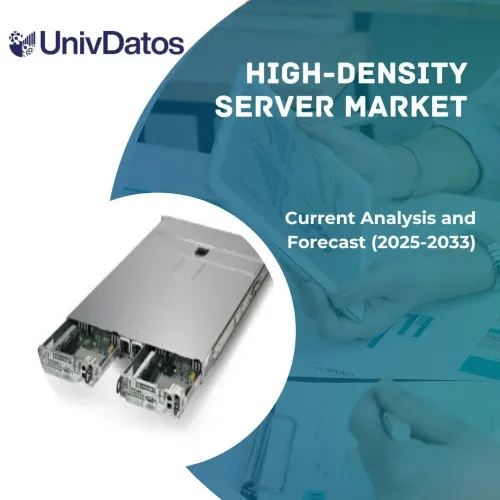餐厅管理软件市场规模与预测
2023年餐厅管理软件市场价值约为550亿美元,预计在预测期(2024-2032年)内将以约16%的显著复合年增长率增长,这归因于技术的日益普及和对非接触式解决方案的需求。
餐厅管理软件市场分析
餐厅管理软件旨在成为一个端到端的软件解决方案,帮助用户运营他们的餐厅。此外,对新的餐厅服务技术的日益接受以及对快餐店服务的需求正在推动全球餐厅管理软件市场的增长。
此外,利用技术管理餐厅运营正在推动全球餐厅管理软件市场。此外,包括排班模板、应用内消息传递和多地点团队管理等功能,可以帮助餐厅员工更高效地管理劳动力成本,并提高员工的工作满意度。
例如,2023年9月12日,甲骨文推出了一个新的经济实惠、易于部署的餐厅管理平台,以帮助独立餐厅增加销售额、提高效率并实现利润最大化。Oracle Restaurants 为运营商提供经过验证的销售点 (POS) 硬件和软件、支付处理以及在线订购功能,所有这些都只需一个低廉的价格。
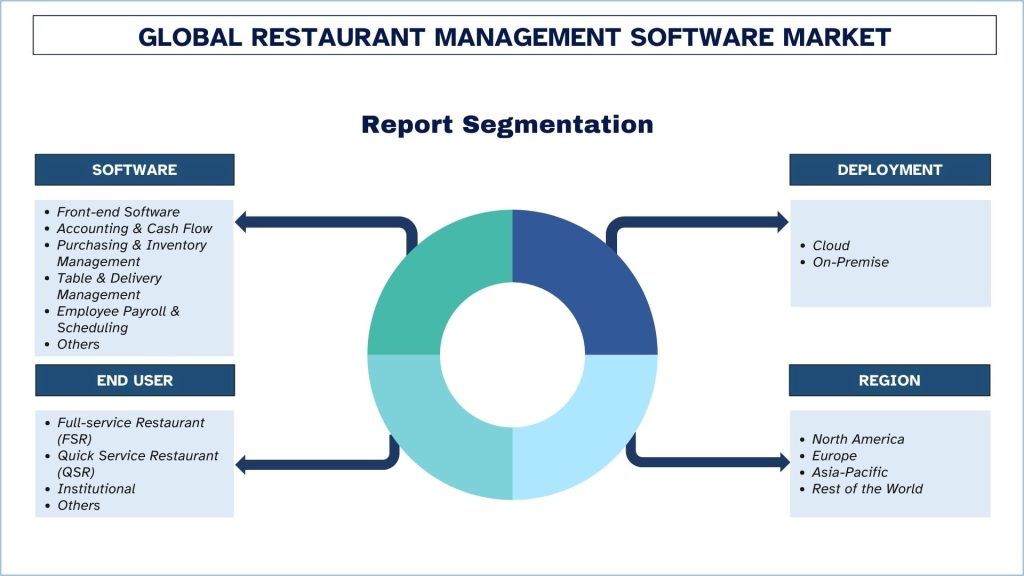
餐厅管理软件市场趋势
本节讨论了影响餐厅管理软件市场各个细分市场的主要市场趋势,这些趋势由我们的研究专家确定。
人工智能和机器学习集成改变餐厅管理软件行业
餐厅管理软件市场中的人工智能和机器学习正在改变商业环境和客户。这些技术有助于对需求、供应和库存进行预测分析,并减少浪费。客户信息被用于营销策略,旨在提高客户兴趣的忠诚度计划由机器学习算法开发,这些算法增强了客户互动。借助支持人工智能的聊天机器人,实时通信和订单管理使业务成为一个简单的过程。此外,它有助于员工管理,因为它分析了人流高峰何时到来,以便可以提前召集更多员工。随着越来越多的餐厅专注于数据分析来做出决策,人工智能和机器学习已变得几乎是强制性的。
例如,2024年4月,Toast 推出了其餐厅管理套件,其中包含针对多门店、企业品牌的新功能。他们添加了基于人工智能的基准测试功能。这些功能加入了该公司基于云的数字技术平台,该平台专为各种规模的餐厅而构建,并在超过100,000个餐厅地点中使用。
北美市场领先
这主要归因于快速的城市化、可支配收入的增加、餐饮服务行业的良好组织特性以及高水平的供应商市场渗透,所有这些都促进了区域产业的增长。因此,供应商正在推出创新的软件解决方案,例如工资单、员工排班和库存管理,以专业地开展后端运营。此外,数字化程度的提高和智能技术的进步,例如自动销售点系统、无线支付方式和虚拟预订系统在该区域的扩张中也应归咎于此。
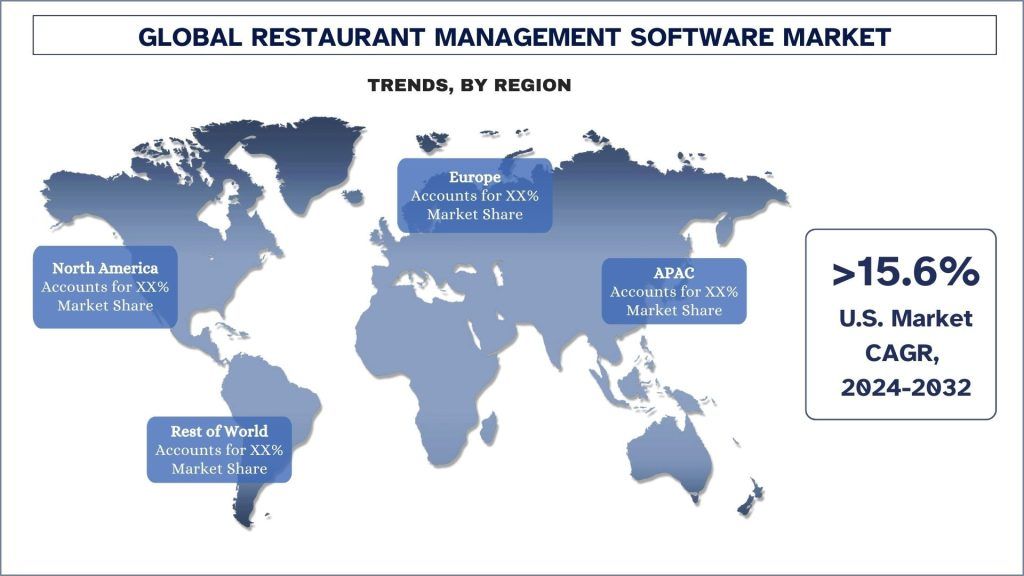
餐厅管理软件行业概览
餐厅管理软件市场竞争激烈,有几个全球和国际参与者。主要参与者正在采取不同的增长战略来增强其市场地位,例如合作、协议、协作、新产品发布、地域扩张以及兼并和收购。市场上运营的一些主要参与者包括 Clover Network, LLC; NCR VOYIX; 甲骨文;Revel Systems; TouchBistro; Toast, Inc.; 7shifts; OpenTable, Inc.; Jolt Software, Inc.; Block, Inc. (Square Capital, LLC)。
餐厅管理软件市场新闻
2024年1月 – 泛团,一家领先的全球亚洲食品配送和生活服务平台,宣布收购 Chowbus 的配送业务。此次收购之后,Chowbus 将专注于开发和优化其餐厅软件即服务 (SaaS) 和销售点 (POS) 业务。
2024年5月20日 – NCR Voyix (NYSE: VYX),一家领先的全球数字商务解决方案提供商,推出了由sunday提供支持的 Aloha Pay-At-Table,以增强整体用餐体验。
餐厅管理软件市场报告范围
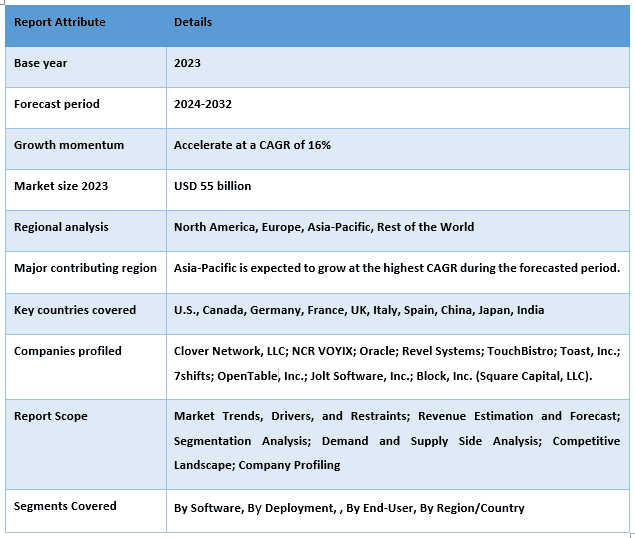
购买本报告的理由:
- 该研究包括经过权威关键行业专家验证的市场规模和预测分析。
- 该报告快速概览了整体行业表现。
- 该报告涵盖了对主要行业同行的深入分析,主要关注关键业务财务、产品组合、扩张战略和近期发展。
- 对行业中普遍存在的驱动因素、限制因素、关键趋势和机遇的详细考察。
- 该研究全面涵盖了不同市场的各个细分市场。
- 对行业的深度区域级分析。
定制选项:
全球餐厅管理软件市场可根据要求或任何其他细分市场进一步定制。除此之外, UMI 理解您可能拥有自己的业务需求,因此请随时与我们联系以获取完全符合您要求的报告。
目录
餐厅管理软件市场分析的研究方法(2022-2032)
分析历史市场、估算当前市场以及预测全球餐厅管理软件市场的未来市场是创建和分析餐厅管理软件在全球主要地区采用情况的三个主要步骤。进行了详尽的二手研究,以收集历史市场数据并估算当前市场规模。其次,为了验证这些见解,考虑了许多发现和假设。此外,还对全球餐厅管理软件市场价值链中的行业专家进行了详尽的主要访谈。在通过主要访谈对市场数据进行假设和验证之后,我们采用自上而下/自下而上的方法来预测完整的市场规模。此后,采用了市场细分和数据三角测量方法来估算和分析行业细分市场和子细分市场的市场规模。详细的方法如下所示:
历史市场规模分析
第 1 步:对二手资料的深入研究:
进行了详细的二手研究,以通过公司内部来源(例如年度报告和财务报表、业绩演示、新闻稿等)以及外部来源(包括期刊、新闻和文章、政府出版物、竞争对手出版物、行业报告、第三方数据库和其他可靠出版物)获取餐厅管理软件的历史市场规模。
第 2 步:市场细分:
在获得餐厅管理软件的历史市场规模后,我们进行了详细的二次分析,以收集主要地区不同细分市场和子细分市场的历史市场洞察力和份额。主要细分市场包括在报告中,如软件、部署、最终用户和地区。进一步进行了国家级分析,以评估在该地区测试模型的整体采用情况。
第 3 步:因素分析:
在获得不同细分市场和子细分市场的历史市场规模后,我们进行了详细的因素分析,以估算餐厅管理软件市场的当前市场规模。此外,我们使用自变量和因变量(例如软件、部署、最终用户和餐厅管理软件市场区域)进行了因素分析。对供需方情景进行了全面分析,考虑了全球范围内餐厅管理软件市场领域的顶级合作关系、兼并和收购、业务扩张以及产品发布。
当前市场规模估算与预测
当前市场规模测算:基于上述 3 个步骤的可操作见解,我们得出了当前的市场规模、全球餐厅管理软件市场的关键参与者以及各细分市场的市场份额。所有所需的百分比份额拆分和市场细分均使用上述二手方法确定,并通过主要访谈进行了验证。
估算与预测:对于市场估算和预测,为包括驱动因素和趋势、限制因素以及利益相关者可用的机会在内的不同因素分配了权重。在分析了这些因素之后,应用了相关的预测技术,即自上而下/自下而上的方法,以得出全球主要市场不同细分市场和子细分市场 2032 年的市场预测。用于估算市场规模的研究方法包括:
就收入(美元)而言的行业市场规模,以及餐厅管理软件市场在全球主要市场的采用率
市场细分市场和子细分市场的所有百分比份额、拆分和细分
就所提供的产品而言,全球餐厅管理软件市场的关键参与者。此外,这些参与者为在快速增长的市场中竞争而采用的增长战略
市场规模和份额验证
主要研究:对主要地区的关键意见领袖 (KOL) 进行了深入访谈,包括高层管理人员 (CXO/VP、销售主管、市场营销主管、运营主管、区域主管、国家主管等)。 然后对主要研究结果进行了总结,并进行了统计分析以证明所提出的假设。 主要研究的输入与次要发现合并,从而将信息转化为可操作的见解。
不同地区主要参与者的划分
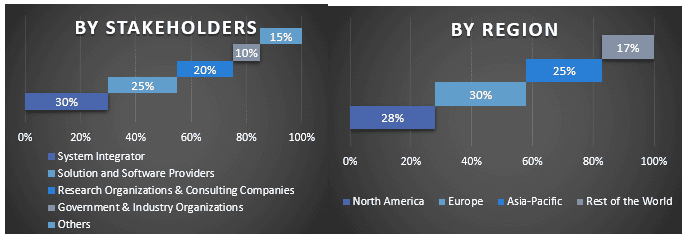
市场工程
采用数据三角测量技术来完成整体市场估算,并得出全球餐厅管理软件市场的每个细分市场和子细分市场的精确统计数字。 在研究了软件、部署、最终用户和全球餐厅管理软件市场的各个地区的各种参数和趋势后,数据被拆分为几个细分市场和子细分市场。
全球餐厅管理软件市场研究的主要目标
研究确定了全球餐厅管理软件市场的当前和未来市场趋势。 投资者可以获得战略见解,以根据研究中进行的定性和定量分析来决定其投资。 当前和未来的市场趋势决定了市场在区域层面的整体吸引力,为行业参与者提供了一个平台,以利用未开发的市场,从而受益于先发优势。 研究的其他定量目标包括:
- 按价值(美元)分析餐厅管理软件市场的当前和预测市场规模。 此外,分析不同细分市场和子细分市场的当前和预测市场规模。
- 研究中的细分市场包括软件、部署、最终用户和地区领域。
- 定义和分析餐厅管理软件的监管框架
- 分析涉及各种中介机构的价值链,以及分析行业的客户和竞争对手行为。
- 分析主要地区餐厅管理软件市场的当前和预测市场规模。
- 报告中研究的主要国家/地区包括亚太地区、欧洲、北美和世界其他地区
- 餐厅管理软件市场的公司概况以及市场参与者为维持快速增长的市场而采用的增长战略。
- 对该行业进行深入的区域层面分析
常见问题 常见问题
第一季度:餐厅管理软件市场的当前规模和增长潜力是什么?
第二季度:餐厅管理软件市场增长的驱动因素是什么?
第三季度:按部署方式划分,哪个细分市场在餐厅管理软件市场中占据最大份额?
第四季度:餐厅管理软件市场的主要趋势是什么?
第五季度:哪个地区将在餐厅管理软件市场占据主导地位?
相关 报告
购买此商品的客户也购买了

